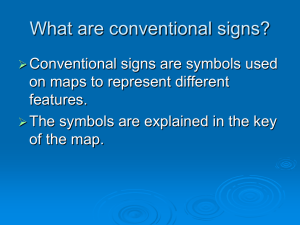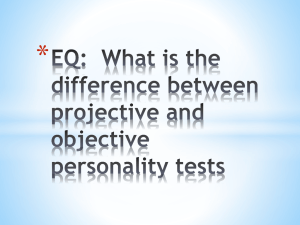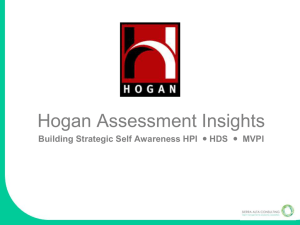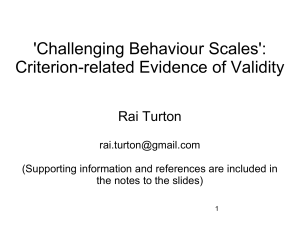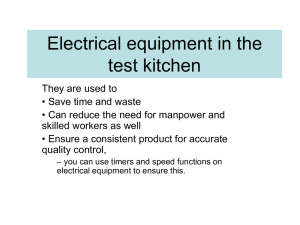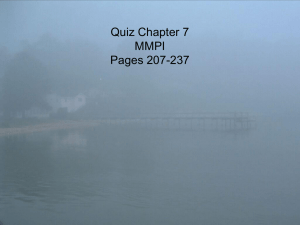Restructured Clinical Scales (RC) Scales
advertisement
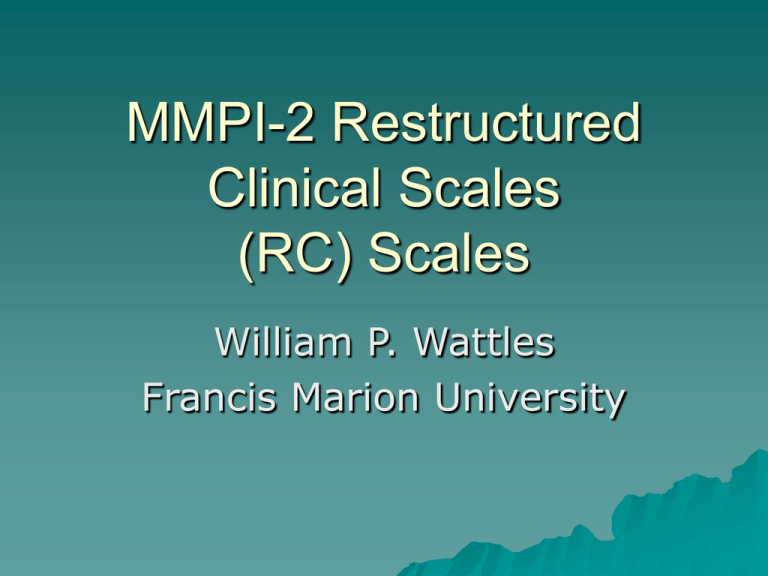
MMPI-2 Restructured Clinical Scales (RC) Scales William P. Wattles Francis Marion University Invalid protocols Cannot say >30 VRIN or TRIN ≥80 F or F(p) ≥100 Fb ≥ 110 L ≥ 80 K ≥ 75 MMPI-2 Good for measuring: – Personality characteristics – Behavioral tendencies – Emotional functioning – Psychopathology symptoms Problem: MMPI-2 Clinical Scales highly intercorrelated Hinders construct validity Empirical keying – convergent – Discriminant Current Techniques – Code types – Harris Lingoes scales – Supplementary scales Construct Validity The extent to which a measurement method accurately represents a construct and produces an observation distinct from that produced by a measure of another construct. Convergent and discriminant validity Convergent and discriminant validity are both considered subcategories or subtypes of construct validity. Convergent and discriminant validity In general we want convergent correlations to be as high as possible and discriminant ones to be as low as possible. Discriminant validity To establish discriminant validity, you need to show that measures that should not be related are in reality not related. Convergent Validity To establish convergent validity, you need to show that measures that should be related are in reality related. Thus, those with elevated scale 4 have been shown to have more arrests. Problem: MMPI-2 Clinical Scales significant item overlap The average number of overlapping items per pair of the ten clinical sales is 6.4 items. Examples – 7-8 – 2-7 – 2-3 – 6-8 – 4-0 (17) (13) (13) (13) (11) Problem: MMPI-2 Clinical Scales highly intercorrelated A factor called anxiety, general maladjustment or emotion distress explains much of the variance among scales. Floating profiles. Intercorrelations result in most or all scales being elevated making it difficult to determine which scale to focus on. Demoralization Scale (RCd) This factor is removed from the other scales Items selected for relevancy to core of each scale Items selected for – Convergence, high correlation with scale – Discrimination, low correlations with other scales. Restructured Scales Intercorrelations Page 157 Intercorrelations are reduced. For example – Scale 1 and Scale 2 =.56 – Scale RC1 and RC2 = .27 – Scale 7 and Scale 2 = .65 – RC7 and RC2 =.31 MMPI-2 RESTRUCTURED CLINICAL SCALES PROFILE Clinical Scale 2 After demoralization is removed a low positive emotionality component emerged. – Consistent with theories seeing this as the core of depression. Clinical Scale 3 When left: RCd removed 3 components – Somatization – Extraversion – Naivete Naivete negatively correlated with psychopathology RC scales evaluation They show convergent validity equal to or superior to the clinical scales and the content scales. They often offer a substantial improvement over clinical scales discriminant validity. (not being significantly correlated to unrelated characteristics.) The RC scales provide a more clearly focused assessment of the primary distinctive components of the Clinical Scales. Interpretation of RC scales RC scale tells about elevations in the core construct. Clinical scale may include other characteristics as well RCd Demorilization High scores (T≥65) – Discouraged – Poor self-esteem – Pessimistic – Expect to fail – Overwhelmed – incapable RC1 Somatic complaints High scores (T≥65) – Large number of physical complaints – Chronic pain – Preoccupied with bodily functions – Resistant to psychological explanations – Develop physical symptoms in response to psychological difficulties RC2 Low Positive Emotions High scores (T≥65) – Lack of positive emotional engagement in life – Lack energy – Difficulty taking charge or making decisions – Inroverted, passive, withdrawn – Bored isolated – Low expectations of success RC3 Cynicism High scores (T≥65) See others as: – untrustworthy – Uncaring – exploitive Low scores (≤40) Naïve Gullible Overly trusting RC4 Antisocial Behavior High scores (T≥65) Difficult to conform to societal norms Difficulties with the law Increased risk for substance abuse Aggressive Conflictual relationships Seen as critical, argumentative, angry, antagonistic. Problems in school and work RC6 Ideas of persecution High scores (T≥65) Feel targeted, controlled and victimized by others. Suspicious, difficulty trusting RC7 Dysfunctional Negative Emotions High scores (T≥65) Anxiety and irritability Often have intrusive, unwanted thoughts Insecure Sensitive to perceived criticism Ruminate and brood about failures Passive and submissive in relationships RC8 Aberrant experiences High scores (T≥65) Sensory, perceptual, cognitive, and motor disturbances suggestive of psychosis. Hallucinations Delusions Scores above 75 suggest schizophrenia, delusional disorder. RC9 Hypomanic activation High scores (T≥65) Thought racing High energy levels Heightened mood & irritability Aggressive, poor impulse control Sensation seekers, risk takers Above 75 suggest bipolar, manic episode 60-70 extraverted with energy Validity The restructured clinical scales provide the most parsimonious assessment of psychopathic personality traits. Incremental Validity Some overlap of present content and supplementary scales. – RC1 Correlates .95 with health concerns – RC3 correlates .93 with cynicism content scale – RCd correlates .95 with Welsh’s Anxiety Scale Summary The RC scales represent a modest psychometric improvement over the standard clinical scales Partial success at removing nonspecific distress variance makes profiles easier to interpret New scales need no data for interpretation
